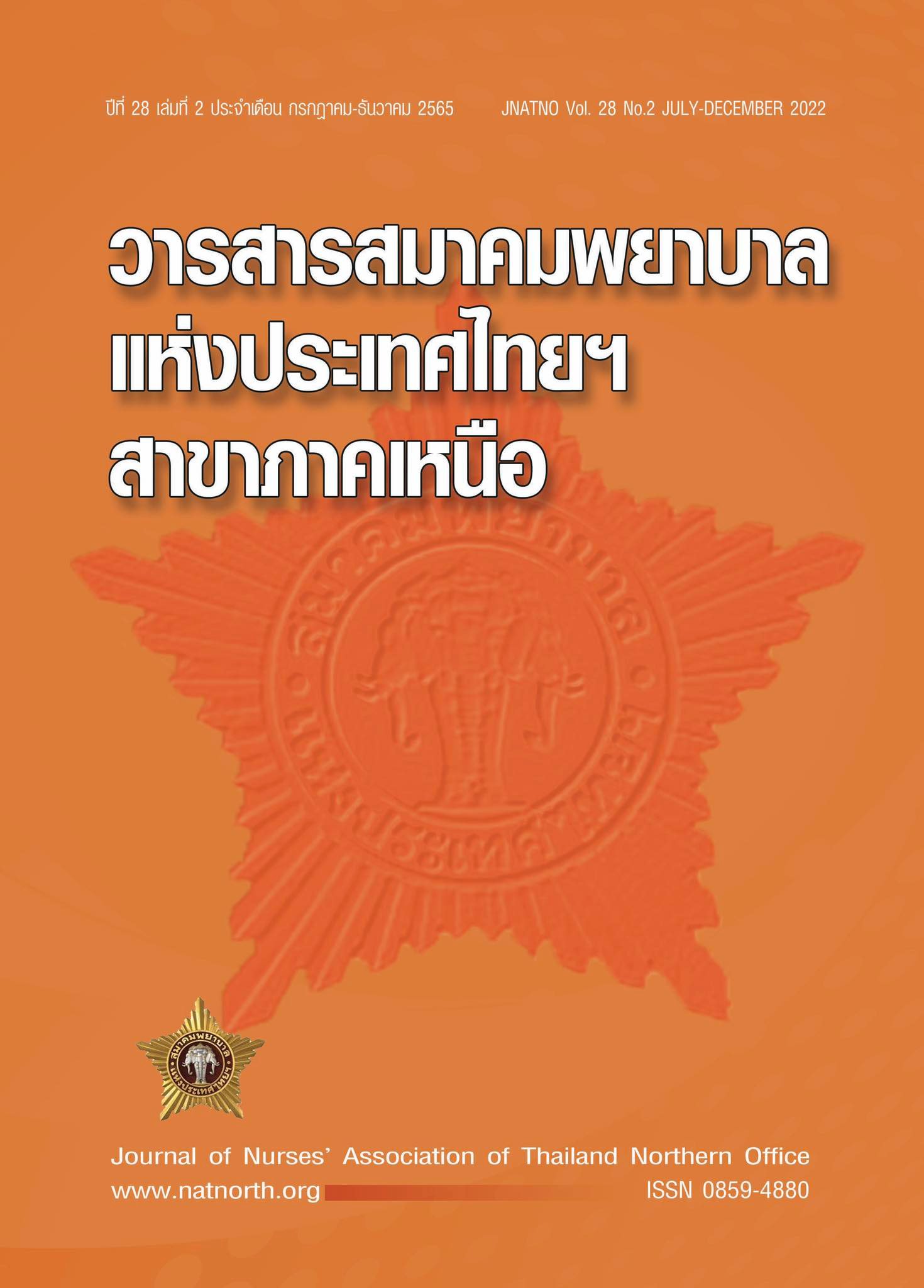The research and development for the prevention of self-extubation among patients with coronavirus diseases and pulmonary tuberculosis
Keywords:
Unplanned extubations, Innovation, Self-extubationAbstract
This research and development (R&D) study aimed to 1) develop an innovation to prevent unplanned extubation from self-extubation, 2) evaluate the effectiveness of the innovation, and 3) evaluate the satisfaction of registered nurses on the use of the innovation. The 146 purposive samples were 146 intubated patients with coronavirus disease 2019 and pulmonary tuberculosis in isolation ward, Mahasarakham Hospital, and 21 registered nurses. The research instruments consisted of in-depth interview questions, a data record form for unplanned extubation, a data record form for pressure sores through physical restraint, and questionnaires on the satisfaction of using the innovation. Data were analyzed using percentage, mean, standard deviation, and content analysis.
The results revealed that the innovation of the “Pa pook rak pitak tube” or “Cloth of Love, a Safeguard for the Tube” that was developed showed durability, and strength, easy to clean, easy to use, convenient, and low cost. It was medical waste disposal. It was found that the innovation significantly helps reducing the rate of self-extubation and the incidence of pressure sore through physical restraints. Furthermore, the satisfaction of registered nurses in using this innovation was in a very high level (91.67%). These results suggest that the innovation could reduce the rate of self-extubation and the prevalence of pressure sores through physical restraints among intubated patients with coronavirus disease 2019 and pulmonary tuberculosis. This innovation should be a part of the nursing care for this groups of patients.
References
Li P, Sun Z, Xu J. Unplanned extubation among critically ill adults: A systematic review and meta-analysis. Intensive Crit Care Nur. 2022:103-219.
da Silva PSL, Fonseca MCM. Unplanned endotracheal extubations in the intensive care unit: systematic review, critical appraisal, and evidence-based recommendations. Anesth Analg. 2012;114(5):1003-14.
Tanios M, Epstein S, Grzeskowiak M, Nguyen HM, Park H, Leo J. Influence of sedation strategies on unplanned extubation in a mixed intensive care unit. Am J Crit Care. 2014;23(4):306-14.
Cosentino C, Fama M, Foà C, Bromuri G, Giannini S, Saraceno M, et al. Unplanned Extubations in Intensive Care Unit: evidence for risk factors: A literature review. Acta Biomed Ateneo Parm. 2017;88(Suppl 5):55-65.
Menon K, Dundon B, Twolan B-L, AlShammari S. Approach to unplanned extubations in a pediatric intensive care unit. Can J Crit Care Nurs. 2015;26(3):25-9.
de Bruijn W, Daams JG, van Hunnik FJ, Arends AJ, Boelens A, Bosnak EM, et al. Physical and pharmacological restraints in hospital care: protocol for a systematic review. Front Psychiatry. 2020;10:921.
Sharifi A, Arsalani N, Fallahi-Khoshknab M, Mohammadi-Shahbolaghi F. The principles of physical restraint use for hospitalized elderly people: an integrated literature review. Syst Rev. 2021;10(1):1-10.
บังอร นาคฤทธิ์ อำภาพร นามวงศ์พรหมและน้ำอ้อย ภักดีวงศ์. การเลื่อนหลุดของท่อช่วยหายใจและระยะเวลาการใส่เครื่องช่วยหายใจในผู้ป่วยวิกฤตที่ได้รับการดูแลโดยใช้แนวปฏิบัติการพยาบาลที่สร้างจากหลักฐานเชิงประจักษ์. วารสารเกื้อการุณย์. 2015;22(1):129-43.
มณีนุช สุทธสนธิ์ ขนิษฐา แก้วกัลยา และวาสนา นัยพัฒน์. ผลของการใช้แนวปฏิบัติการพยาบาลต่ออัตราการเกิดท่อช่วยหายใจเลื่อนหลุดในผู้ป่วยอาการหนักที่ใส่ท่อช่วยหายใจ. วารสารการพยาบาลและการศึกษา. 2017;10(2):58-70.
วิภารัตน์ นาวารัตน์ พนมพร พฤทธิพงศ์พันธุ์ ปริชาติ ศรีอนุรักษ์ ปทุมพร กานยะคามิน และสุวีณา เบาะเปลี่ยน. ผลของการใช้แนวปฏิบัติการพยาบาลเพื่อป้องกันท่อช่วยหายใจเลื่อนหลุด โดยไม่ได้วางแผนต่ออัตราการเลื่อนหลุดของท่อช่วยหายใจ ในหอผู้ป่วยอายุรกรรม โรงพยาบาลพระมงกุฎเกล้า. วารสารพยาบาลทหารบก. 2560;18(1):167-75.
กุสุมาลย์ รามศิริ นิติภา เพชรสิงห์ และจีระพรรณ วันหากิจ. ประสิทธิผลการพัฒนาระบบการดูแลผู้ป่วยต่ออุบัติการณ์การถอดท่อช่วยหายใจโดยไม่ได้วางแผน หอผู้ป่วยวิกฤติศัลยกรรม โรงพยาบาลเลย. ชัยภูมิเวชสาร. 2019;39(1):16-25.
หอผู้ป่วยเฉพาะโรค โรงพยาบาลมหาสารคาม. รายงานสรุปตัวชี้วัด เกณฑ์ และผลลัพธ์การดูแลผู้ป่วย หอผู้ป่วยเฉพาะโรค โรงพยาบาลมหาสารคาม ประจำปี 2564. มหาสารคาม: โรงพยาบาลมหาสารคาม; 2564.
วรนาฎ วุฒิเป็ก. การพัฒนาการพยาบาลในการป้องกันท่อช่วยหายใจเลื่อนหลุด. ศรีสะเกษ, โรงพยาบาลขุขันธ์; 2560.
สว่าง ปานบัว และนาตยา คำสว่าง. การป้องกันการเกิดท่อช่วยหายใจเลื่อนหลุดจากการที่ผู้ป่วยดึงออกเอง หอผู้ป่วยหนักอายุรกรรม 1. พิษณุโลก: โรงพยาบาลพุทธชินราช; 2563.
ไพลิน ชินคำ ณัฎฐ์กานต์ อรรถอาภา และภัทราพร โตสาลี. การป้องกันการเลื่อนหลุดของท่อช่วยหายใจในผู้ป่วยวิกฤต. นครสวรรค์: โรงพยาบาลค่ายจิรประวัติ; 2560.
อ้อย เกิดมงคล และปิยภรณ์ หลักมั่น. ถุงมือมหัศจรรย์ลดการดึงท่อช่วยหายใจ (สาขาอายุรกรรม). แม่ฮ่องสอน: โรงพยาบาลศรีสังวาลย์; 2561.
อนุชา ไทยวงษ์ กัญญาพัชร เบ้าทอง กานต์รวี โบราณมูล มลฤดี แสนจันทร์ และวัชราภรณ์ ศรีโสภา. นวัตกรรมทางการพยาบาลในการสนับสนุนและส่งเสริมความสามารถในการดูแลตนเองสำหรับผู้ป่วยมะเร็งศีรษะและคอที่ได้รับรังสีรักษา. วารสารโรงพยาบาลมหาสารคาม. 2018;15(3):159-68.
Nastasi BK, Schensul SL. Contributions of qualitative research to the validity of intervention research. J Sch Psycho. 2005;43(3):177-95.
Doğan A, Karasu F, Yilmaz L. The effects of nurses’ use of personal protective equipment on their vital signs during the COVID-19 pandemic. Work. 2022(Preprint):1-8.
Choudhury A, Singh M, Khurana DK, Mustafi SM, Ganapathy U, Kumar A, et al. Physiological effects of N95 FFP and PPE in healthcare workers in COVID intensive care unit: A prospective cohort study. Indian J Crit Care Med. 2020;24(12):1169.
Downloads
Published
How to Cite
Issue
Section
License
Copyright (c) 2022 Nurse' Association of Thailand Northern Office

This work is licensed under a Creative Commons Attribution-NonCommercial-NoDerivatives 4.0 International License.
บทความที่ได้รับการตีพิมพ์เป็นลิขสิทธิ์ของสมาคมพยาบาลแห่งประเทศไทยฯ สาขาภาคเหนือ
เนื้อหาและข้อคิดเห็นใดๆ ที่ตีพิมพ์ในวารสารสมาคมพยาบาลฯ ถือเป็นความรับผิดชอบของผู้เขียนเท่านั้น ผู้เขียนบทความต้องศึกษารายละเอียดหลักเกณฑ์การจัดทำต้นฉบับตามที่วารสารกำหนด และเนื้อหาส่วนภาษาอังกฤษต้องได้รับการตรวจสอบจากเจ้าของภาษามาแล้ว


